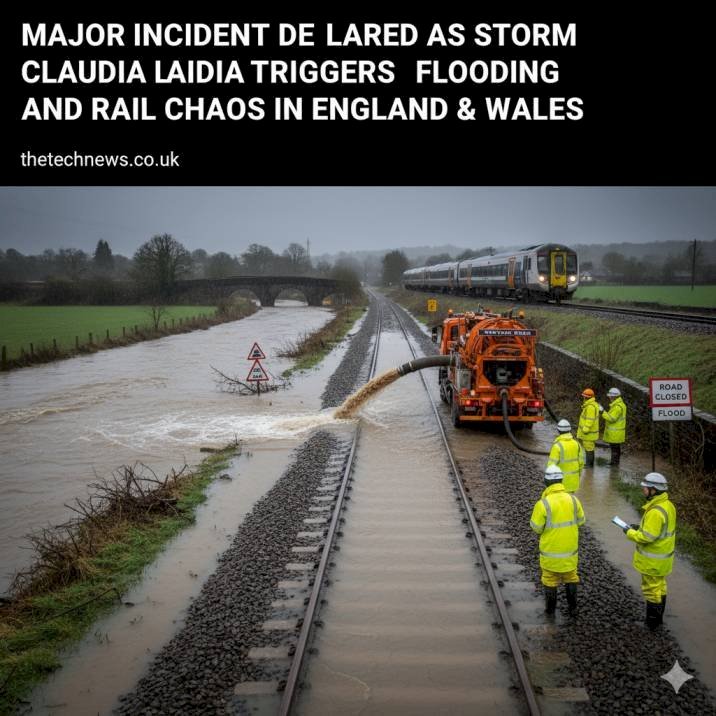Major Incident Declared as Storm Claudia Triggers Flooding and Rail Chaos in England & Wales
Storm Claudia triggers severe flooding and major rail disruption across England and Wales. Met Office warnings, travel chaos, and emergency responses continue.

Storm Claudia has caused widespread chaos and severe flooding across England and Wales, with some areas receiving a month’s worth of rain in just 24 hours, prompting "major incident" declarations and extensive travel disruption.
The Met Office issued amber and yellow weather warnings as the intense rainfall triggered major travel chaos and emergency responses across both nations. Heavy rainfall associated with Storm Claudia led to rivers bursting their banks, notably in Monmouth, South East Wales,where authorities declared a major incident. Emergency crews, including fire services and mountain rescue teams, conducted evacuations and rescues as floodwaters inundated homes, businesses, and transport infrastructure.
The Environment Agency reported dozens of active flood warnings across England and Wales, with some locations experiencing dangerous conditions and significant property flooding. Flooding blocked multiple rail routes and roads, disrupting hundreds of journeys across the region.
Rail disruption was extensive, with services cancelled or heavily delayed across several key routes including Paddington to Bristol and South Wales lines. Operators such as Transport for Wales, Chiltern Railways, and CrossCountry urged passengers to avoid non-essential travel. Network Rail teams worked tirelessly through the night pumping out floodwater, inspecting tracks, and conducting repairs to restore services safely.
The worst-affected regions included Wales, the Midlands, South West England, South East England, and eastern England. Specific towns like Monmouth,Gloucestershire, and Oxfordshire faced the brunt of flooding and subsequent travel disruption.
Public safety warnings were repeatedly issued by authorities. Residents and drivers were urged to avoid flooded areas, heed road closures, and take great care near deep standing water. The Environment Agency and local councils stressed the dangers of floodwaters, noting that even shallow water can lead to serious accidents.
Although rainfall is expected to ease later Sunday, water levels remain dangerously high, prolonging disruption and raising concerns over flood damage recovery. The Met Office further forecasted colder conditions following the storm, warning of risks including frost and icy patches which may hinder ongoing travel and restoration efforts.
Official responses highlight the seriousness of this event. A Network Rail spokesperson said, “We are doing everything we can to ensure services run as safely and smoothly as possible under these challenging conditions.” Met Office meteorologists emphasized the unprecedented intensity of the rainfall over already saturated grounds. Local councils and emergency services underscored the logistical difficulties in rescue and recovery operations across severely affected communities.
The human impact has been significant. Commuters were stranded and events postponed due to the extensive train cancellations and delays. Hundreds of residents faced property damage, evacuations, and ongoing flood-related hardship. Emergency services remain on high alert, prioritizing public safety amid rising flood dangers.
Passengers planning to travel are strongly urged to consult up-to-date travel information on National Rail Enquiries and individual train operator websites. Monitoring alerts from the Met Office and Environment Agency is essential. Those able should consider alternative routes or postpone non-essential travel until conditions improve.
About thetechnews.co.uk
thetechnews.co.uk is dedicated to delivering high-quality, timely news across technology, transportation, climate, and societal impacts. We strive to inform readers with clear, expert analyses and comprehensive updates that help navigate how emerging events shape everyday life and the future. Committed to journalistic integrity and accessibility, thetechnews.co.uk is your trusted source for insightful and reliable news coverage.
Frequently Asked Questions (FAQ)
Q1: What caused the widespread flooding during Storm Claudia in England and Wales?
A1: Storm Claudia brought intense and persistent rainfall, with some areas receiving up to a month’s worth of rain in 24 hours. This heavy rain caused rivers to burst their banks, leading to widespread flooding across England and Wales, especially in regions like Monmouth, South East Wales.
Q2: Which areas were most affected by Storm Claudia’s flooding and rail disruptions?
A2: The worst-affected areas included Wales, the Midlands, South West England, South East England, and eastern England. Towns such as Monmouth, Gloucestershire, and Oxfordshire experienced severe flooding, and key rail routes like Paddington to Bristol and South Wales faced significant service cancellations and delays.
Q3: What travel disruptions did Storm Claudia cause on train services?
A3: Train services across England and Wales faced major delays and cancellations due to flooding on track and blocked routes. Operators like Transport for Wales, Chiltern Railways, and CrossCountry advised passengers to avoid non-essential travel while Network Rail pumped floodwaters and inspected tracks for safety.
Q4: What safety advice was given to residents and travelers during Storm Claudia?
A4: Authorities urged people to avoid flooded areas, heed road closures, and never drive or walk through floodwaters. Passengers were advised to check live travel updates, follow Met Office and Environment Agency alerts, and use alternative routes or postpone travel if possible.
Q5: What weather warnings were issued before and during Storm Claudia?
A5: The Met Office issued amber and yellow rain warnings across affected regions. These warnings highlighted the risk of heavy rainfall, flooding, and strong gusty winds, with some locations recording rainfalls exceeding average monthly totals, prompting emergency responses.
Q6: How long is the disruption from Storm Claudia expected to last?
A6: While rainfall was expected to ease by Sunday, water levels remained high, likely prolonging flooding and travel disruptions into the following days. Colder weather with frost and icy patches was also forecasted, adding further challenges for recovery and travel.

 AnniWeston
AnniWeston 













